Nvidia says leading aerospace and automotive companies are accelerating complex engineering tasks by as much as 500x using its new DoMINO NIM microservice, part of the Nvidia PhysicsNeMo AI physics framework.
According to the company, the combination of GPU-accelerated computing, AI-powered physics modelling and interactive digital twins is transforming how enterprises run simulations for aircraft, vehicles and heavy machinery.
The platform enables “near real-time simulation” of physical systems, significantly compressing design cycles and allowing engineers to explore larger design spaces with far greater accuracy.
Nvidia says this level of speed “unlocks incredible speedups and gives solutions providers the freedom to explore groundbreaking designs at previously inconceivable scales and accuracy”.
Synopsys reports 500x engineering speedup
Simulation firms are already reporting step-change gains. Ansys, part of Synopsys, is using Nvidia PhysicsNeMo to achieve computational engineering speedups of “up to 500x”.
The performance jump comes from combining GPU acceleration with AI-driven physics models. The framework provides a highly accurate initial state for fluid simulations – a traditionally costly and iterative process – which cuts runtime and multiplies performance gains.
Nvidia says fluid simulations can run “up to 50x faster” using GPU-accelerated tools such as Ansys Fluent, and that using PhysicsNeMo pretrained models for the initial state multiplies that by an additional 10x.
Real-time aerospace design
Aerospace manufacturers are among the earliest adopters. Northrop Grumman and Luminary Cloud are applying Nvidia’s accelerated compute stack to spacecraft thruster nozzle design.
Luminary’s CUDA-X-accelerated CFD solver enabled Northrop to generate a large dataset to train a surrogate nozzle model on Luminary’s cloud platform, powered by PhysicsNeMo. This allowed engineers to rapidly test thousands of design options and identify optimal configurations.
Blue Origin is also using PhysicsNeMo to help design next-generation space vehicles. The framework allows the company to combine existing and augmented datasets to train AI models that can explore design candidates rapidly before validating results with high-fidelity CUDA-X solvers.
Building on GPU-accelerated engineering
Nvidia’s work follows broader industry momentum toward GPU-accelerated computational engineering. Cadence is pushing real-time simulation through its Cadence Fidelity CFD platform, powered by Nvidia CUDA-X libraries.
Its Millennium M2000 supercomputer is helping aerospace manufacturers create large AI training datasets and interactively optimise designs.
A global energy company has used Cadence Fidelity LES Solver and Nvidia Grace Blackwell-accelerated platforms to run high-fidelity multiphysics simulations for turbine systems.
According to Nvidia, this approach cuts development time while improving efficiency, emissions performance and reliability for next-generation energy infrastructure.
The company says the breakthroughs represent a new phase of AI-driven engineering where simulation speed and accuracy reshape how complex systems are designed across aerospace, automotive and energy sectors.

